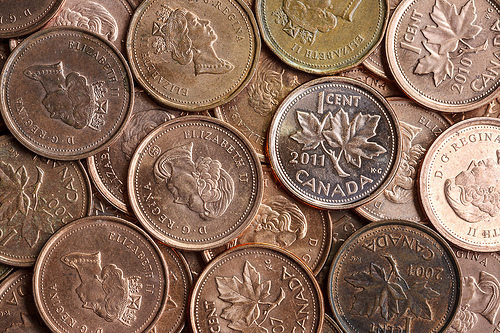By Stephanie Vandervelde (Contributor) – Email
Print Edition: January 16, 2013
As of February 4, 2013, pennies—or the lack thereof—will begin to lighten the weight of our wallets in more ways than one. As new procedures come into play, transactions are going to become a question of how much extra cash is sitting in your pockets.
According to The Canadian Press, if you pay with cash at the till, your total will be rounded to the nearest five cent increment. However, if you pay with debit or credit, you will pay the exact total that pops up on the screen. While in some cases paying with cash could save you money, it could also begin to cost you. Sure, Canadian taxpayers will be saving some $11 million annually, but what does that really mean when it comes to the cash in our pockets? Who will be responsible for deciding if our total will get rounded up or down? Will the computers be modified to make the necessary changes when the cashier hits the pay by cash button? While it seems simple enough to just round it up, there are so many finite details that are not being addressed or accounted for.
Federal government guidelines will have prices ending in .01, .02, .06 or .07 rounded down, and those ending in .03, .04, .08 or .09 rounded up. An example for rounding in Ontario was shown that if a product is offered for sale at $1.08 and the business rounds to the nearest five cent increment, the total including HST will be $1.22 before rounding and $1.20 after rounding. Confused yet? As the scenarios continue to arise, the situation becomes more and more muddled and unclear.
Of course the Royal Canadian Mint asked our opinions on this whole ordeal, so we should feel confident it is the right thing to do. “We want to thank all Canadians for sharing their views with us, especially as it relates to this transition.”
Saving $11 million is rather appealing to Canadians. But what we fail to realize is that although we are saving millions in one area, we are spending it somewhere else; that is, on the introduction of new plastic bills.
The production cost of these new bills is double that of the old paper bills. While claims that the new bills will last 2.5 times longer should make this cost irrelevant, the recent claims of the plastic bills melting—on the front dashboard of the car on a hot day, or in the dryer—seem to contradict this logic.
We may be currently focused on the soon-to-expire penny, for now, but it is only a matter of time before its five cent brother is following in its footsteps.
Where does this leave the nickel? Canadians have begun hoarding them, much like they have done for decades with the penny. This suggests that the nickel, like the penny, has outgrown its usefulness. Nickels are being forgotten in the bottom of change purses, tossed into fountains and left unwanted in gutters, while the country opts for the larger dime and quarter to fulfill their needs. As time goes on our coins may become larger in worth, or perhaps disappear altogether into electronic transactions.
Our money’s future is un-predictable. Considering the slippery slope analogy, when one coin goes out it’s only a matter of time before the next coin follows. And considering Canadians’ money woes, we might not be sorry if the rest of the coins in our pockets turn into bills.


